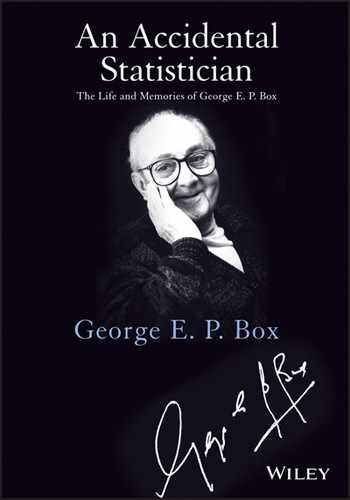Second Foreword
It is a pleasure to welcome this autobiography of an extraordinary scholar and gentleman: George Edward Pelham Box. My intersection with George Box's long and active statistics career begins in the summer of 1952, when I was a research associate at the Aberdeen Proving Grounds, MD, working for Dr. Frank Grubbs. Dr. Grubbs and I together read George Box's wonderful paper on response surface experimentation,1 and I recall how we both marveled at its simplicity … obvious of course now that the message was offered! Originality and elucidation are the signs of Box's genius. On returning that September to my graduate studies at the Institute of Statistics, NC State, in Raleigh, I learned that George Box had agreed to come to Raleigh for a year as a visiting Research Professor. In January 1953, I became his first graduate student.
It's a pleasure to read about George's boyhood. His father worked hard to provide a modest family environment in a society that offered advantaged youths the greatest opportunities. We learn how George, through the good fortune of meeting alert teachers, uncovered his talents as a writer and more modestly in mathematics. He starts his young adult life as an assistant chemist collecting data on wastewater treatment, and it is here that his career as a statistician begins. And what a career it proved to be!
One of George Box's distinguishing characteristics is that he only occasionally published a paper as a sole author. This memoir introduces us to a host of his students and research associates, and it provides colorful vignettes of these many wonderfully varied personalities who became his co-authors. Some ten years ago, a group of his students gathered together a compendium of his papers covering the statistical fields of quality, experimental design, control, and robustness.2 Both neophytes and savants have found the exposition within these many papers superb. Of course, there are also his co-authored textbooks on experimental design,3 time series analysis,4 Bayesian inference,5 and control,6 wherein elucidation of the subject's theory and application repeatedly prove both original and illuminating. For George Box, the acronym “KISS” translates into “Keep It Sophisticatedly Simple.”
I found one recollection of George Box's early statistical experiences particularly fascinating. Near the end of World War II, the British came into possession of German explosive shells containing unknown deadly gases. George was part of the small group that first determined the spectacular deadliness of tiny concentrations of these new reagents (actually nerve gases). They were never employed in warfare, but had portions been dropped over major cities, the population consequences could easily have rivaled those of Hiroshima and Nagasaki. To have been present working along that thin boundary keeping the world from additional disaster is impressive.
We learn, too, of those whom George Box considered his mentors and hear tales of his early collaborations with others well known among the statistical fraternity. And throughout this autobiography, we become aware of Box's broad contributions to modern statistical theory and practice. His papers and books have vastly expanded awareness of Bayesian methods and time-series modeling. We find the production of information-laden data to be a statistical specialty that enhances scientific progress as it moves from initial conjecture through experimentation and data analysis, leading on to new conjecture. And beyond statistically formal matters, we also capture his deep appreciation for the mind's ability, or better still that of a collection of minds, to give birth to new models and not usual conjectures. It seems that George Box's advice to all those pondering a problem is to be sure to think out of the box.
J. Stuart Hunter
Professor Emeritus
Princeton University
1 “On the Experimental Attainment of Optimum Conditions” Box, G. E. P. and Wilson, K. B. (1951) Jour. Royal Stat. Soc. Series B, 13, 1–45.
2 Box on Quality and Discovery: George Tiao, Søren Bisgaard, William J. Hill, Daniel Peña, Stephen M. Stigler. (2000) John.Wiley & Sons.
3 Statistics for Experimenters: Box, G.E.P, Hunter, William G. and Hunter, J. Stuart (1978) John Wiley & Sons.
4 Time Series Analysis: Forecasting and Control: Box, G.E.P and Jenkins, Gwilym M. (1970) Holden Day.
5 Bayesian Inference in Statistical Analysis: Box, G.E.P. and Tiao, George C. (1973) Addison Wesley.
6 Statistical Control by Feedback and Adjustment: Box, G.E.P. and Lucño, Alberto (1997) John Wiley & Sons
